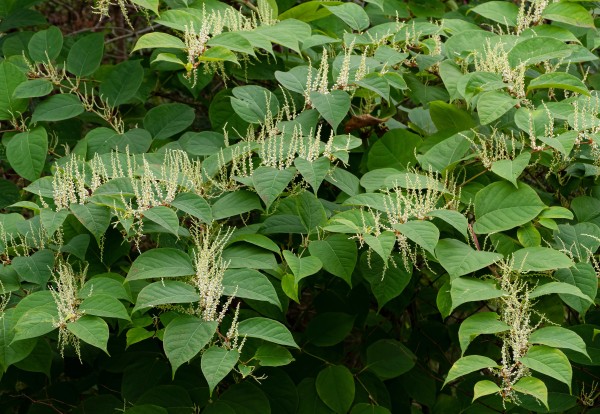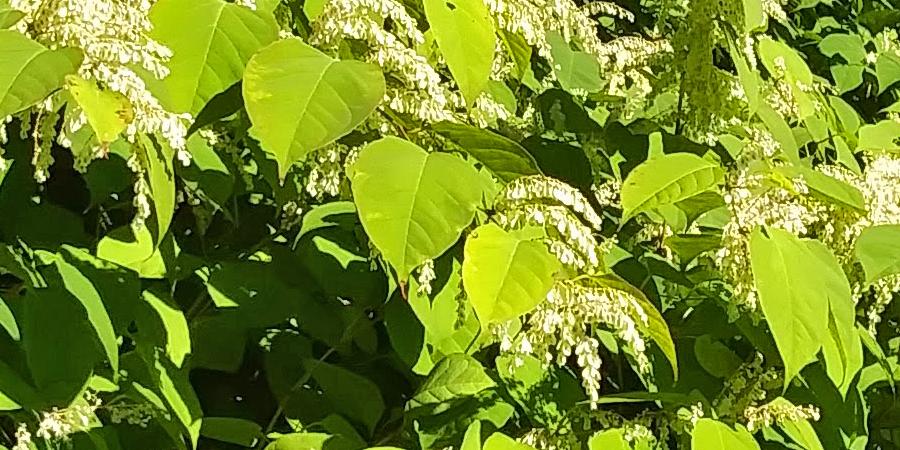The Ausable watershed supports a variety of plant and animal species, playing a critical role in the local environment and economy, but its health is threatened by invasive species. Some of the species the Ausable Freshwater Center (AFC) is paying special attention to include knotweed species, reed canary grass, round goby, and Chinese mystery snail.
Japanese Knotweed
Japanese knotweed (Fallopia japonica) is a notorious invasive plant that has spread throughout various parts of the Ausable watershed. Introduced from East Asia in the 19th century as an ornamental plant, knotweed has since proven to be incredibly adaptable and difficult to manage. We are working to identify knotweed locations in the watershed, and partnering with organizations like the Adirondack Park Invasive Plant Program to treat existing infestations.
Impacts:
- Habitat Loss: Japanese knotweed forms dense thickets that can crowd out native plants. This displacement reduces plant diversity, affecting wildlife that depend on native vegetation for food and habitat.
- Erosion and Sedimentation: The plant’s extensive root system can destabilize riverbanks and contribute to increased soil erosion. This erosion leads to sedimentation in streams and rivers, which degrades water quality and impacts aquatic habitats.
- Management Difficulties: Knotweed is notoriously difficult to control due to its robust root system, ability to establish quickly, and rapid growth. This makes management efforts labor-intensive and costly.

Reed Canary Grass
Reed canary grass (Phalaris arundinacea) is another invasive species found in the Ausable watershed. Native to Eurasia and introduced to North America for erosion control and forage, reed canary grass has become an agricultural remnant species and a dominant presence in many wetland areas.
Impacts:
- Wetland Degradation: Reed canary grass quickly takes over wetlands, reducing plant diversity and altering the structure of these critical habitats. These changes impact water filtration, flood regulation, and the overall health of wetland ecosystems.
- Competes with young replacement trees: This species can grow and establish faster than young replacement tree seedlings, overtaking and shading them out. This competition is challenging for tree planting sites across the region.
- Displacement of Native Species: By crowding out native plants, reed canary grass disrupts the food sources and habitats of native wildlife, including birds, insects, and amphibians.
- Management difficulties: Reed canary grass is extremely difficult to manage due to its rapid regrowth and its extensive rhizomes, making it challenging to remove.

Support our biodiverse habitats work for wildlife and their habitats. Give with confidence today!
Round Goby
The round goby (Neogobius melanostomus) is a small fish native to Eastern Europe and Asia that has spread to the Hudson, Mohawk, and Saint Lawrence Rivers and threatens to spread to the Lake Champlain Basin. Introduced through ballast water from ships, the round goby is an aggressive competitor in aquatic environments. Our partners at the Lake Champlain Basin Program are carefully tracking the spread of this aggressive invasive fish.
Impacts:
- Competition with Native Fish: Round gobies outcompete native fish species for food and spawning sites. This intense competition can lead to declines in populations of important fish species, such as trout and bass.
- Disruption of Food Webs: The round goby preys on the eggs and larvae of native fish, disrupting the local food web and affecting the overall health of aquatic ecosystems.
- Spread of Disease: Round gobies can carry parasites and diseases that are transmissible to native fish, further exacerbating the impact on local fish populations.

Chinese Mystery Snail
The Chinese mystery snail (Cipangopaludina chinensis), also known as the Chinese apple snail, is an invasive mollusk that has established populations in several water bodies across North America. AFC staff have found this snail in several local water bodies, including the Saranac River, Union Falls Pond, and Lincoln Pond.
Impacts:
- Impact on Aquatic Communities: Chinese mystery snails outcompete native snails and other invertebrates for resources. Their feeding habits can significantly alter nutrient cycling and sedimentation patterns, impacting water quality and the health of aquatic ecosystems.
- Threat to Native Species: By detrimentally reducing populations of algae and aquatic plants, Chinese mystery snails affect the native organisms that rely on these resources, potentially leading to a decline in overall biodiversity.

Addressing Invasive Species
The presence of invasive species in the watershed highlights the need for effective management and prevention strategies. Here are some steps that AFC has taken to mitigate their impact:
- Monitoring and Early Detection: Regular monitoring and early detection of invasive species are essential for managing their spread. Prompt action can prevent small infestations from becoming larger, more difficult problems.
- Public Awareness: Teaching communities about the impacts of invasive species and promoting practices that prevent their spread, such as cleaning boats and equipment before moving between water bodies, can help reduce the introduction and spread of invasive species.
- Collaboration: Collaboration between local communities, conservation organizations, and government agencies is crucial for effective management and restoration efforts.
Protecting the Ausable from invasive species requires a coordinated effort. By understanding the threats posed by species like Japanese knotweed, reed canary grass, round goby, and Chinese mystery snail and taking proactive measures to address them, we can help preserve the ecological health and resilience of this valuable watershed for future generations.
The Ausable Freshwater Center (AFC) continually strives to prevent and manage invasive species throughout the watershed. Our river steward educates anglers and community members about invasive species and how they can effectively clean their equipment before and after traveling to new bodies of water. Along the West Branch Ausable River, AFC maintains ten wader wash stations at popular fishing access sites to encourage anglers to clean their waders with a saline solution to kill any potential hitchhikers. We have five hiking boot brush stations at trailheads throughout the area. Additionally, we monitor the watershed regularly to detect any potential new invasions promptly and track existing infestations.
Organizations like ours can't do it alone. Citizen scientists can help manage invasive species. iMapInvasives is an accessible, collaborative database that assists members of the public with uploading sightings of invasive species, thus enabling organizations to effectively track and manage infestations. Anyone can get involved in preventing the spread.
Story by Meghan Bargabos, River Steward. Top photo: Japanese knotweed
Sign-up for our e-newsletter to get weekly updates on the latest stories from the Ausable Freshwater Center.


